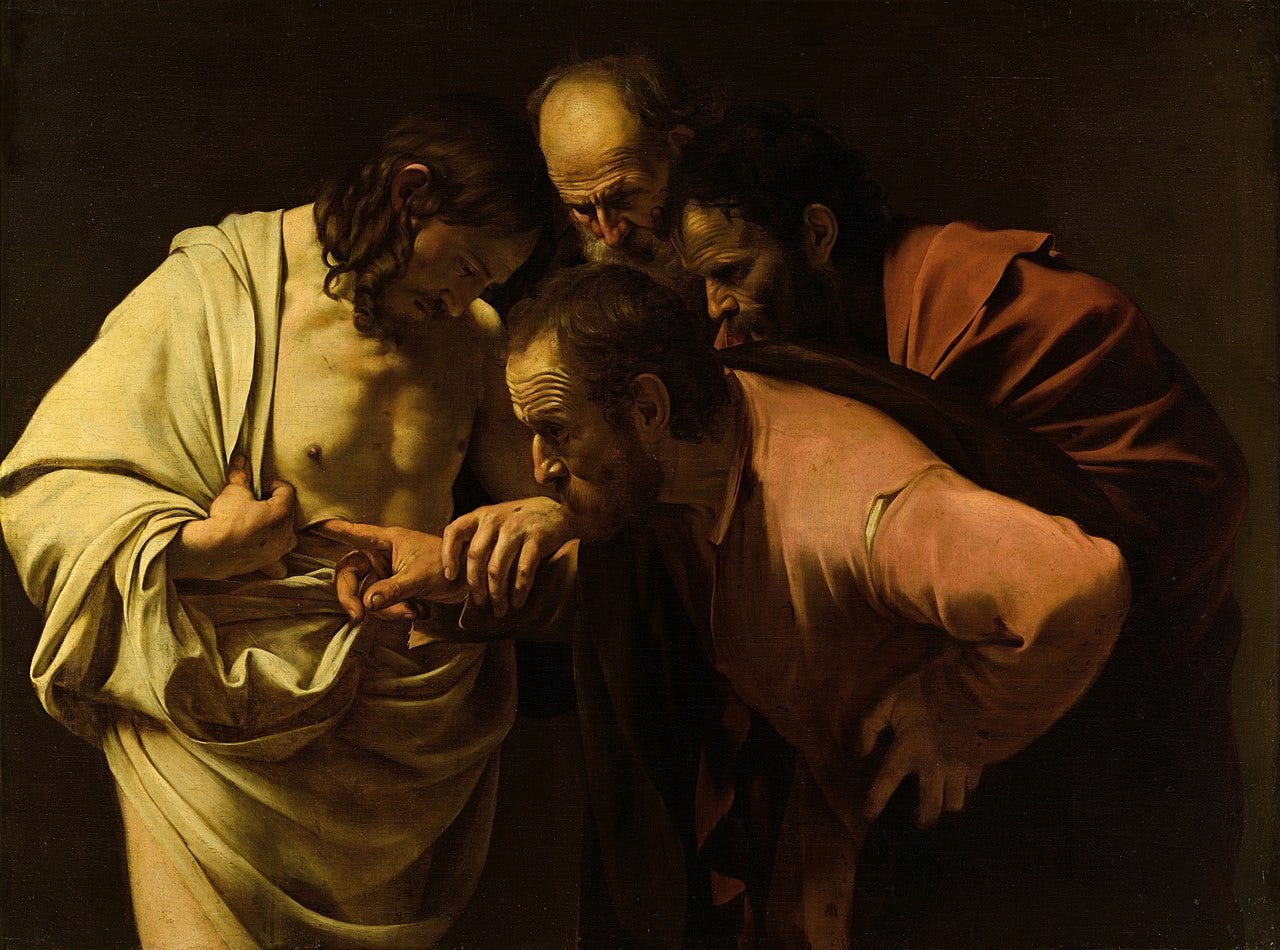
There are few painters whose biographies attract as much interest as Caravaggio’s does. Although modern art critics like to play up Caravaggio’s temper and antics, he was also one of the greatest defenders of the Catholic faith during the Counter-Reformation.
He was certainly no saint, but through painting, he probed profound questions about faith and doubt, matter and spirit, poverty and faith, conversion and martyrdom.
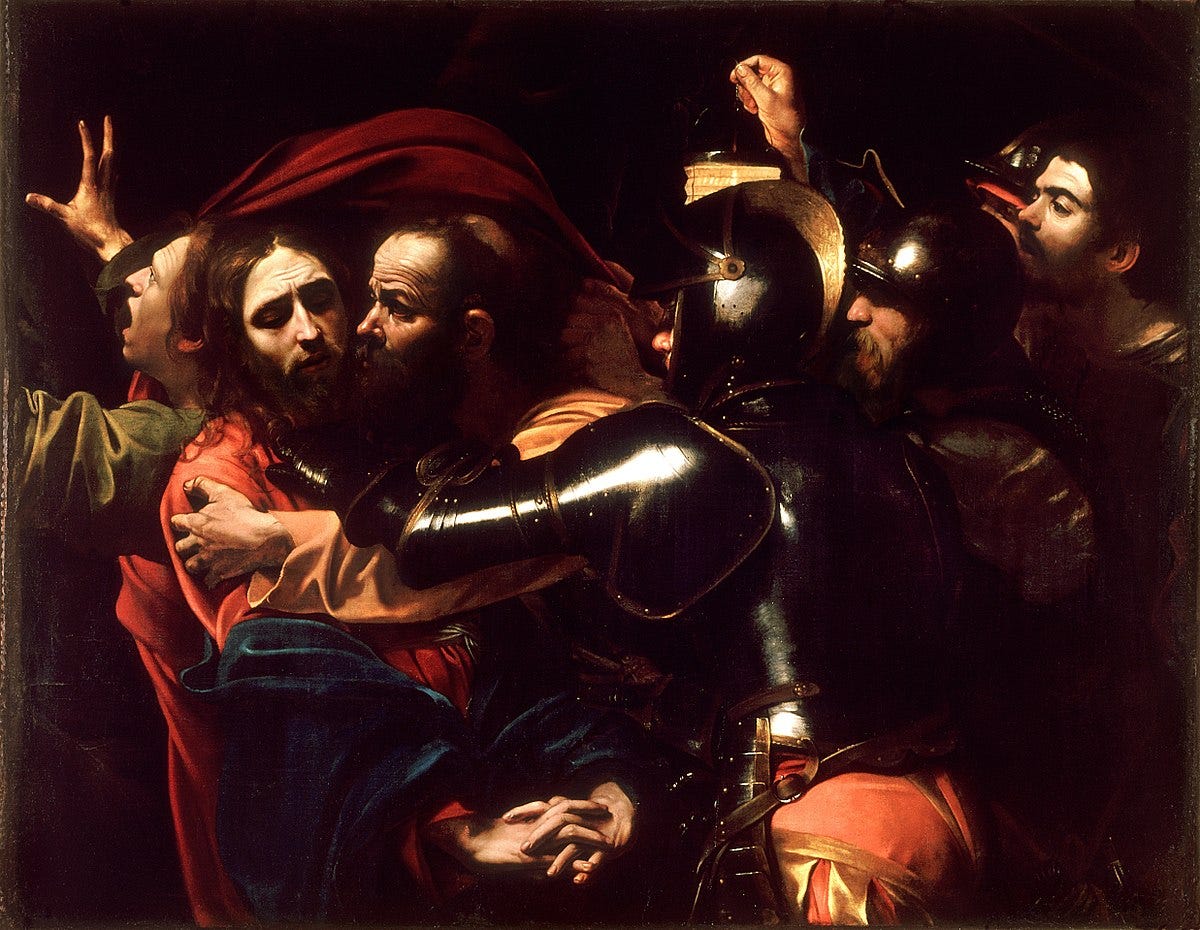
It’s hard to avoid being confronted by his work when you’re in the same space as one of his paintings. This is partly due to how he uses dramatic staging and foreshortening to depict figures who often seem to be on the verge of falling out of the frame or swatting you in the face. In the painting “The Incredulity of Saint Thomas,” Thomas’s elbow protrudes into our space and draws attention to his ripped tunic.
Caravaggio is known for painting the most dramatic moment of a story and making it even more intense than you imagined. This technique works incredibly well in the context of religious paintings. We are often not shocked enough by the strange truths of our faith. Caravaggio makes it easy for us to imagine ourselves in the scenes he paints, but he clearly imagines himself in them too. In the painting of Saint Thomas he clearly identifies himself with the figure whose head juts out of the darkness in the very center of the painting, St. Thomas the Apostle.
Most of the painting is shrouded in total darkness, except for Christ and the heads of three apostles, who together form a diamond shape at the center of the painting. The lighting is dark but not harsh. The colors are actually quite warm and earthy.
Light emanates from Christ’s body and highlights the apostles' wrinkled foreheads and stunned facial expressions. Their fascination reveals that Thomas was not the only one who had some doubts. Their eyes are fixated on Thomas’s probing finger.
From Thomas’s face, we are led to his finger, which features quite a bit of dirt under the nails. A patient and serene Christ compassionately guides Thomas’s dirty finger into his fresh wound.
The scene comes from the passage in the Gospel of John:
Although the doors were shut, Jesus came and stood among them and said, “Peace be with you.” Then he said to Thomas, “Put your finger here and see my hands. Reach out your hand and put it in my side. Do not doubt but believe.” Thomas answered him, “My Lord and my God!” Jesus said to him, “Have you believed because you have seen me? Blessed are those who have not seen and yet have come to believe. (John 20:24-29)
The painting is shockingly visceral and emphasizes the reality of Christ’s bodily Resurrection as well as the Incarnation. The rough appearance of the apostles reminds us of how Christ invites us, despite our sin and wretchedness, into his body, into the Church, offering us forgiveness.
The way the light and shadows of the painting mingle reminds us of how faith and doubt mingle in our lives. Christ meets us in the shadows and invites us to rest in him and bring him our doubts and questions. This painting also recalls the ancient Anima Christi prayer: “Within your wounds hide me; never allow me to be separated from you.”
Despite the emphasis on doubt, the painting also has a sacramental confidence. The attention to Christ’s fleshy body reminds us of how Christ brings us into his body through the sacraments, chiefly the Eucharist. In fact, early Church Fathers understood this passage from the Bible in a Eucharistic way. For example, in the fifth century, Saint Cyril of Alexandria explained in his commentary on the Gospel of John:
And, to adopt the language of allegory… Christ visits us and appears unto us all, both invisibly and also visibly; invisibly as God, but also visibly in the Body. He suffers us to touch His holy Flesh, and gives us thereof. For through the grace of God we are admitted to partake of the blessed Eucharist, receiving Christ into our hands, to the intent that we may firmly believe that He did in truth raise up the Temple of His body. For that the partaking of the blessed Eucharist is a confession of the Resurrection of Christ is clearly proved by His own words... Let us, therefore, after touching Christ's Body, shrink back from unbelief in Him as utter ruin, and rather be found well grounded in the full assurance of faith.
The emphasis on entering into Christ’s body in this painting harkens back to this understanding of the passage in John.
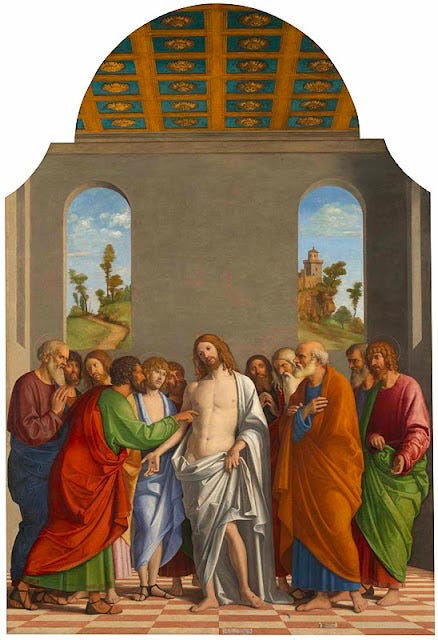
This particular passage of John inspired many paintings throughout the Middle Ages and Renaissance. Caravaggio was the first painter to depict the emotional shock of this moment, and he clearly hit a nerve because it’s the one of the most copied paintings of the era. Prior paintings often featured the group of the disciples rather focusing on the individual experience of Saint Thomas.
Baroque art often emphasizes the individual experience, pushing back on the Protestant notion that the clutter and clericalism of Catholicism made this impossible. During the Counter Reformation, Catholic artists often made the point that personal experience is essential, but it happens in the context of the Church. Christ invites us to receive his body still in the Eucharist, which is a personal experience.1
Baroque Art also often responded to the Protestant principles of John Calvin which put a wedge between matter and spirit: “Finitum non est capax infiniti" (The finite cannot contain the infinite) and "Quantum sensui tribueris tantum spiritui detraxeris" (The physical detracts from the spiritual). In all fairness however, it appears that most modern Protestants have shifted away from this negative view of matter back toward their Catholic roots.
In his recently published book They Flew, Yale professor Carlos Eire explains: “Moreover, Reformed metaphysics proposed that matter is not only incapable of bridging the gap between heaven and earth; it actually acts as an obstacle. "The more you focus on material things," said Zwingli, "the more you take away from the spiritual." John Calvin agreed: "Whatever holds down and confines the senses to the earth is contrary to the covenant of God; in which, inviting us to Himself, He permits us to think of nothing but what is spiritual."
Here, Caravaggio counters these dictums by showing how the physical draws us into the spiritual. Though we can’t probe our fingers into Christ’s body like Thomas did, meditating on paintings can pull us more deeply into the mysteries of the faith, as do the sacraments and sacramentals.
After Pentecost, Saint Thomas is said to have traveled to India, where he gained the favor of a King who wanted him to build him a palace. Thomas’s devotion to evangelization put him in a precarious position with the Indian King, but Thomas continued to evangelize and build numerous churches. Eventually, it is said Thomas was hunted and speared for his faith, which is depicted in this dramatic scene by another Baroque painter, Peter Paul Reubens.
Thomas may be known for his doubt, but it certainly did not have the last word in his life.
The personal experience of saints was also framed in the context of the drama of the spiritual life, which was stunted in much of Protestant Theology because of ideas like double predestination.




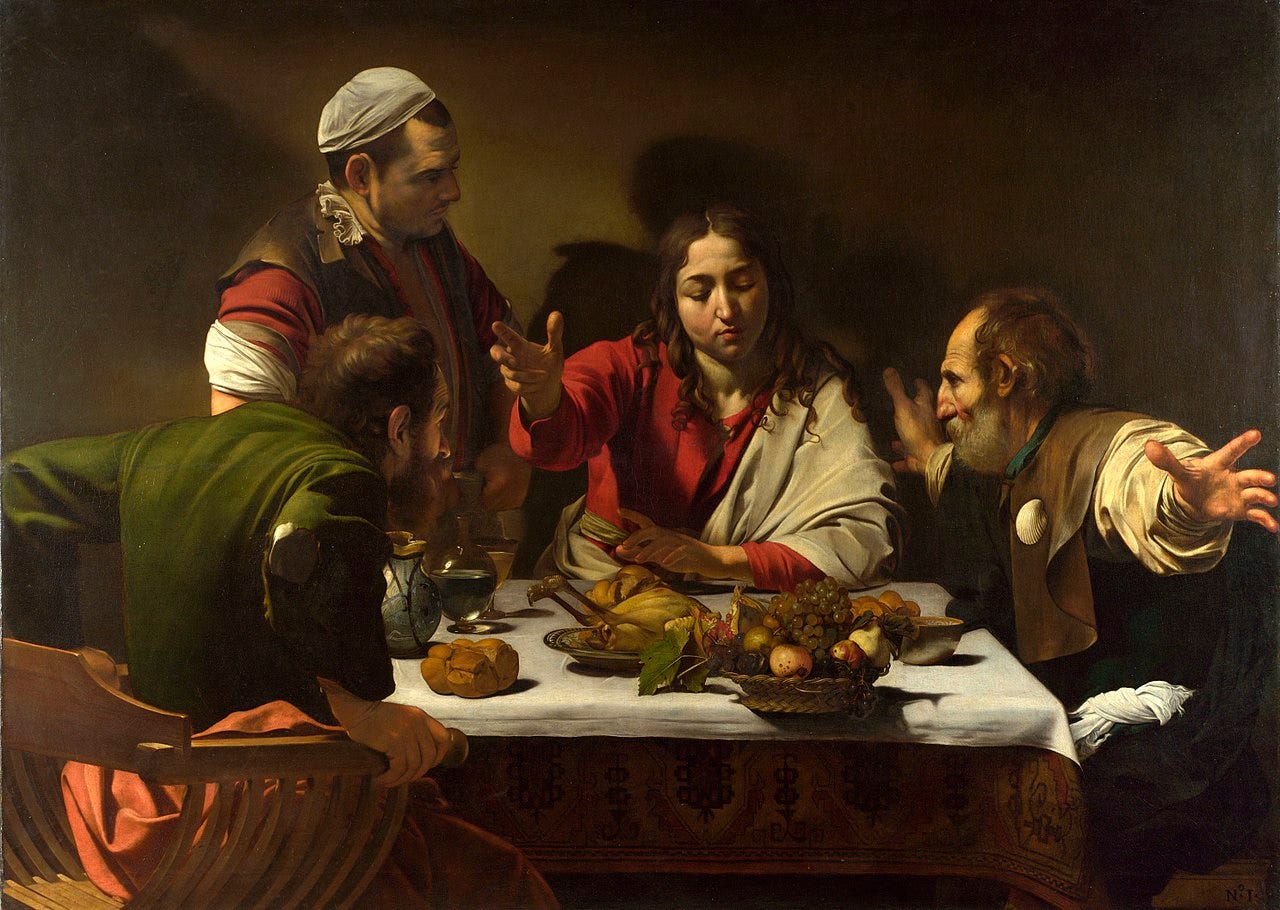


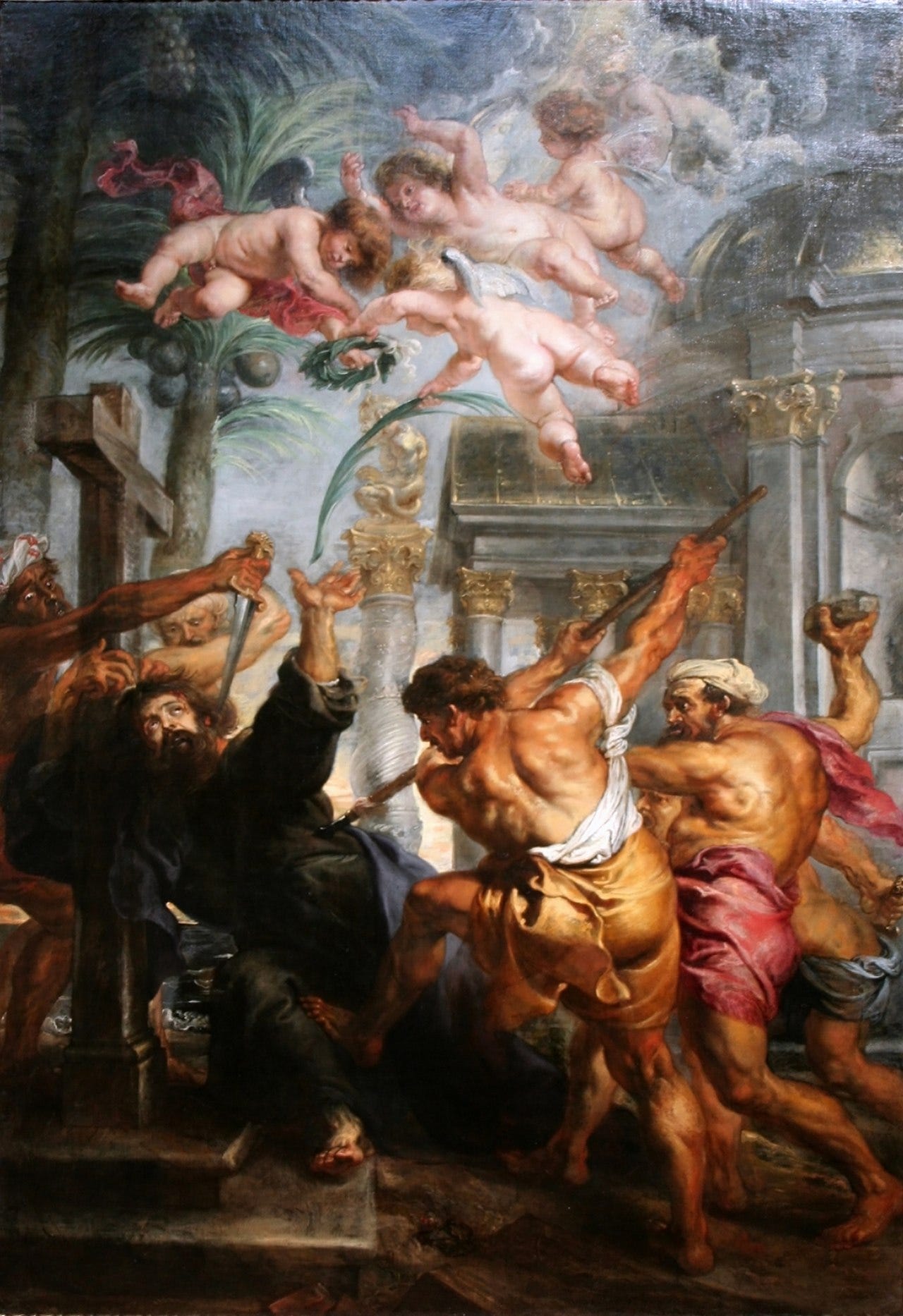
Beautiful connection! Thank you for sharing the poem. I really enjoyed reading your poetic response to Graham-Dixon’s biography.
Wonderful commentary. I really like Caravaggio and it has bothered me that so many focus on his shortcomings. Clearly he could not paint the way he did without being God inspired. I wish people would focus on how he opened up and filled in some of the mysteries of the Bible moments he depicted.